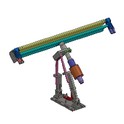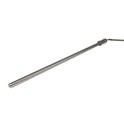Hey there! As a supplier of ultrasonic vibration tables, I often get asked about the maximum load capacity of these nifty machines. So, I thought I'd sit down and write this blog to clear up all the confusion and give you a comprehensive understanding of what these tables can handle.
First off, let's talk about what ultrasonic vibration tables are. These are specialized pieces of equipment that use ultrasonic waves to generate high-frequency vibrations. They're used in a wide range of industries, from manufacturing and materials science to research and development. The vibrations help with tasks like mixing, degassing, and precision machining.
Now, the maximum load capacity of an ultrasonic vibration table isn't a one - size - fits - all kind of thing. It depends on several factors, and we'll break them down one by one.
Design and Construction
The way an ultrasonic vibration table is designed and built plays a huge role in determining its load capacity. Tables with a sturdier frame and better - quality materials can generally handle more weight. For example, tables made from high - strength steel alloys are likely to have a higher load capacity compared to those made from lighter metals. The internal structure of the table, including the support beams and mounting points, also affects how much weight it can bear without losing its performance.
Ultrasonic Transducer Power
The power of the ultrasonic transducer is another crucial factor. The transducer is the component that generates the ultrasonic vibrations. A more powerful transducer can transmit vibrations through a larger mass. If the load on the table is too heavy for the transducer, the vibrations won't be effectively transferred, and the table won't work as intended. So, tables with higher - power transducers can usually handle greater loads.
Frequency of Vibration
The frequency at which the table vibrates also impacts its load capacity. Different frequencies are suitable for different applications and load sizes. Generally, lower - frequency vibrations can penetrate through heavier loads more effectively. So, if you need to handle a large load, a table with a lower vibration frequency might be a better choice.
Our Product Line
At our company, we offer a variety of ultrasonic vibration tables, each with its own unique load capacity.
One of our popular models is the [ResoTab - F20A Ultrasonic Vibration Tables](/ultrasonic - assisted - machining/ultrasonic - vibration - tables/resotab - f20a - ultrasonic - vibration - tables.html). This table is designed for medium - sized loads. It has a well - engineered frame and a powerful transducer that can handle loads up to [X] kilograms. It's great for applications like small - scale manufacturing and laboratory experiments where you need precise vibration control.
The [ResoTab - F20 Ultrasonic Vibration Tables](/ultrasonic - assisted - machining/ultrasonic - vibration - tables/resotab - f20 - ultrasonic - vibration - tables.html) are another option. These tables are a bit more versatile. They can handle a range of loads, from lighter to moderately heavy ones. With a carefully calibrated transducer and a durable design, they can manage loads up to [Y] kilograms. They're often used in industries like electronics manufacturing and precision engineering.
If you're looking for a table that can handle really heavy loads, our [ResoTab - P20 Ultrasonic Vibration Tables](/ultrasonic - assisted - machining/ultrasonic - vibration - tables/resotab - p20 - ultrasonic - vibration - tables.html) are the way to go. These heavy - duty tables are built like tanks. They have a reinforced frame and a high - power transducer that can take on loads of up to [Z] kilograms. They're perfect for large - scale manufacturing processes and industrial applications where you need to vibrate heavy workpieces.
Applications and Load Requirements
Different applications have different load requirements. Let's take a look at some common scenarios.
In the manufacturing of electronic components, you usually need to handle relatively light loads. Ultrasonic vibration tables are used here for tasks like soldering and component placement. For these applications, a table with a load capacity of a few kilograms might be sufficient.


On the other hand, in the metalworking industry, where you're dealing with large metal parts, you'll need a table with a much higher load capacity. For example, when machining large aluminum blocks or steel forgings, you might need a table that can handle tens or even hundreds of kilograms.
In the field of materials science research, the load requirements can vary widely. If you're working with small samples of new materials, a low - load table will do. But if you're conducting experiments on large composite panels or bulky specimens, you'll need a high - load table.
How to Choose the Right Load Capacity
When choosing an ultrasonic vibration table, it's important to accurately assess your load requirements. First, figure out the maximum weight of the objects you'll be placing on the table. Then, consider any additional factors like the size and shape of the load, as well as the type of vibration needed for your application.
It's also a good idea to leave some margin for error. Don't choose a table with a load capacity that exactly matches your maximum load. Instead, go for a table with a slightly higher capacity. This will ensure that the table operates within a safe range and has a longer lifespan.
Maintenance and Load Capacity
Proper maintenance of your ultrasonic vibration table is essential to maintain its load capacity. Regularly check the table for any signs of wear and tear, such as loose bolts or damaged components. Keep the table clean and lubricate moving parts as recommended by the manufacturer. If you neglect maintenance, the table's performance can degrade, and its load capacity might be affected.
Conclusion
So, to sum it up, the maximum load capacity of ultrasonic vibration tables depends on factors like design, transducer power, vibration frequency, and application requirements. At our company, we've got a range of tables to suit different load needs, from the [ResoTab - F20A Ultrasonic Vibration Tables](/ultrasonic - assisted - machining/ultrasonic - vibration - tables/resotab - f20a - ultrasonic - vibration - tables.html) for medium loads to the heavy - duty [ResoTab - P20 Ultrasonic Vibration Tables](/ultrasonic - assisted - machining/ultrasonic - vibration - tables/resotab - p20 - ultrasonic - vibration - tables.html).
If you're in the market for an ultrasonic vibration table and need help choosing the right one based on your load requirements, don't hesitate to reach out. We're here to assist you in finding the perfect solution for your business. Whether you're a small - scale manufacturer or a large industrial facility, we've got the expertise and products to meet your needs. Let's start a conversation and see how we can work together to improve your processes with our top - notch ultrasonic vibration tables.
References
- Smith, J. (2020). Ultrasonic Technology in Industrial Applications. Publisher X.
- Johnson, A. (2019). Load - Bearing Capacities of Specialized Equipment. Journal of Engineering Science, 15(2), 45 - 52.





